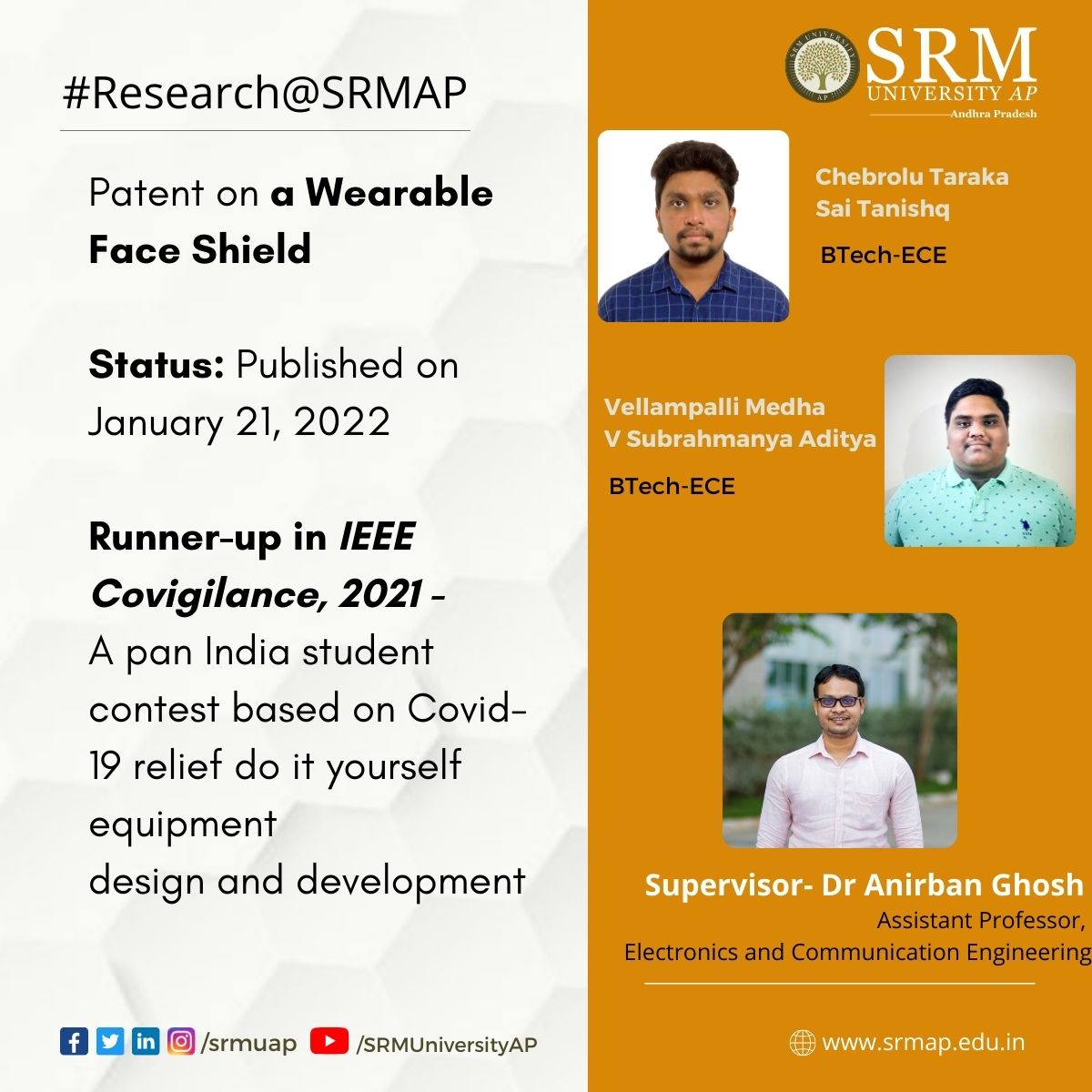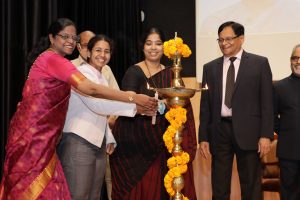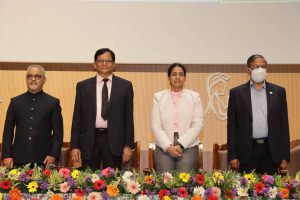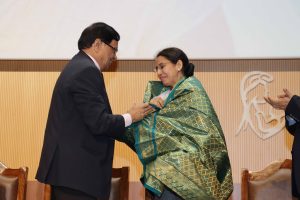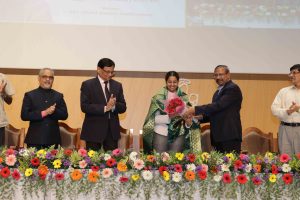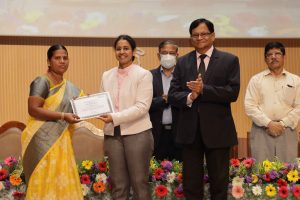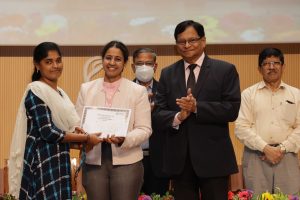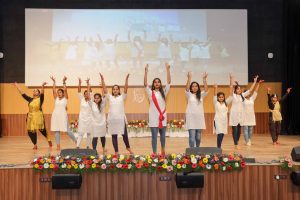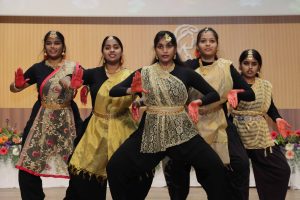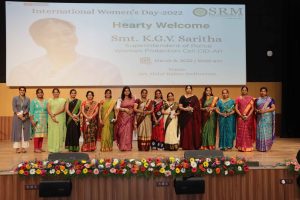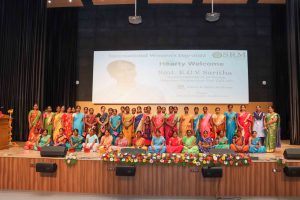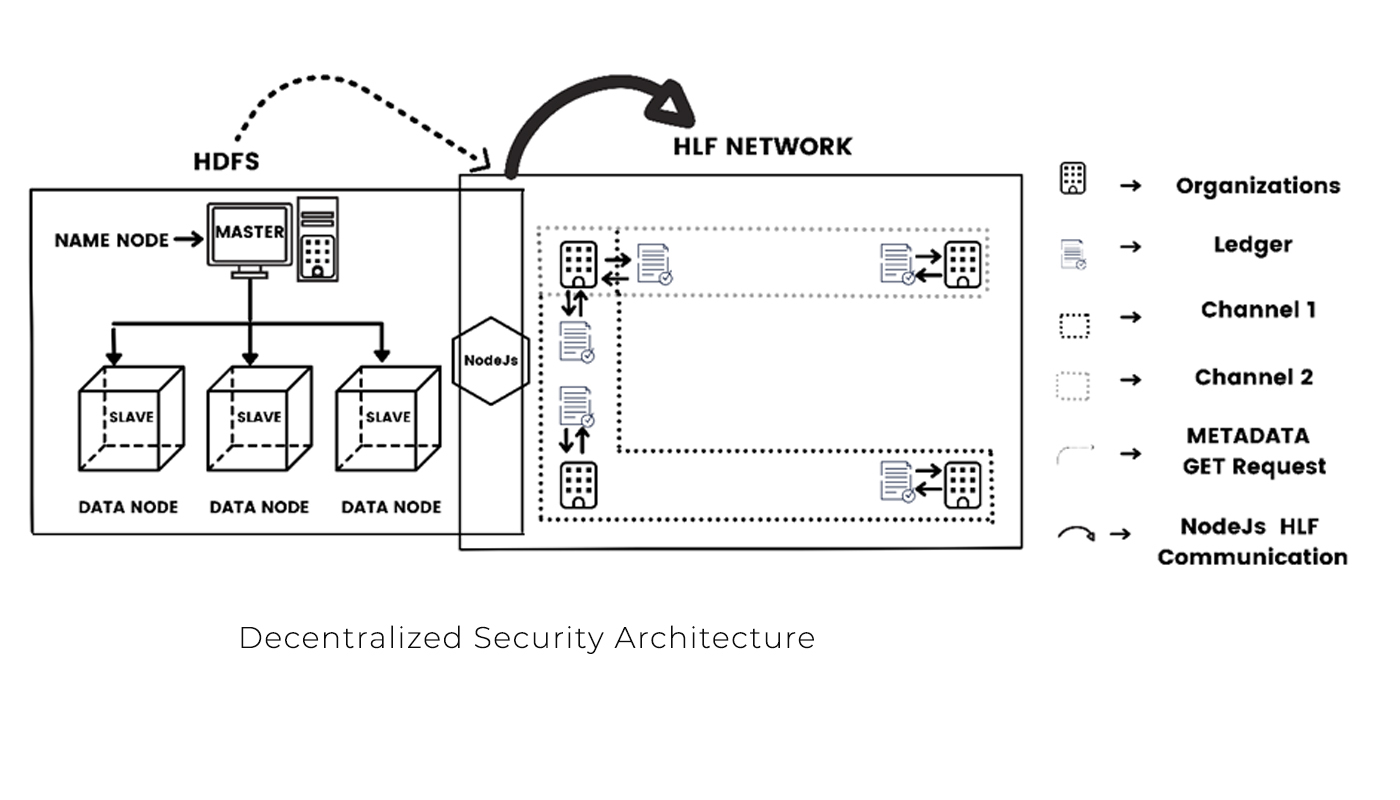An incredible feat of Mechanical Engineering student
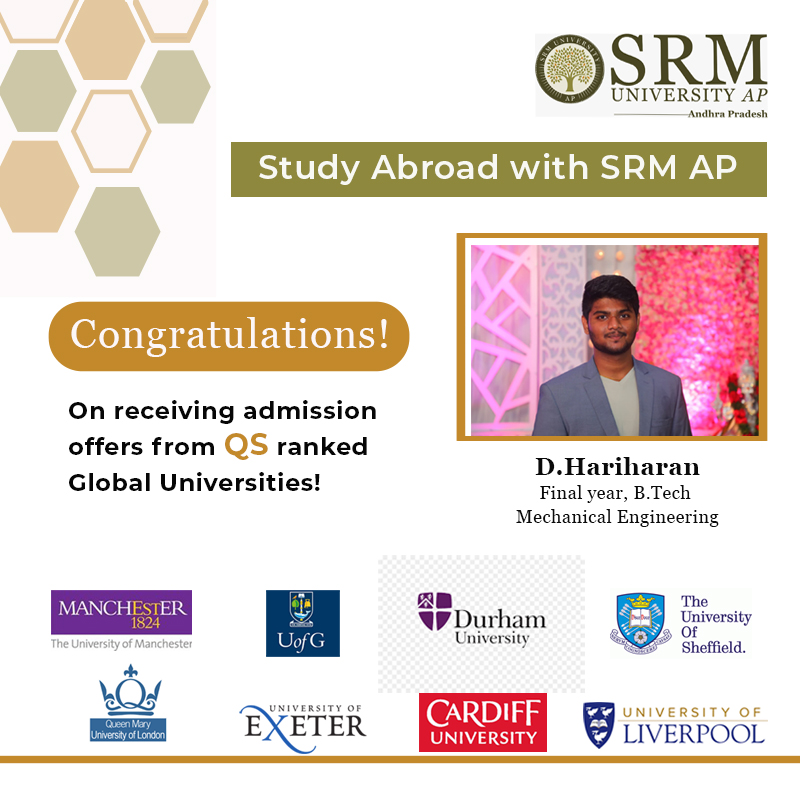
It is a moment of pride and celebration for the Department of Mechanical Engineering at SRM University-AP as Hariharan D, Final year, BTech Mechanical Engineering bags admission offers from multiple top-ranked overseas universities including the University of Manchester that ranks 27 in the QS World University Rankings.
Moulding up the students through the right training and plotting out the right pathway for them to scale further heights have always been the primary objective of the faculty of SRM University-AP. “Happy to hear that you got placed in a core dream company. I hope this will not dampen your aspirations to go for higher studies. Indeed, students like you should study as far as you can. You should bring more laurels to this institution and make us proud”, this was the message Hariharan received from his faculty mentor, Dr Pramod Jammy, which kindled his spirit to set off for higher studies abroad.
“I am ever grateful to my beloved faculty mentors, Dr Pramod Jammy, Dr Lakshmi Sirisha and Dr Surfaraz Halkarni, for their constant support, inspiration and Letter of Recommendations provided amidst their busy schedules. I also thank my Department Head, Dr Prakash Jadhav, for his continuous motivation”, remarked Hariharan.
According to him, creating an imposing CV and impactful SoP is the deciding factor of the application process. He expressed his gratitude to the entire department for their effective involvement in every bit of the application process. “To build an attractive SoP and resounding CV, we need credentials like decent CGPA, involvement in departmental activities such as webinars, internships, workshops, minor projects, software skills, etc. Also, the close association with the department faculties right from the first year is essential to get their affinity and the commendable Letter of Recommendations” he added.
Forging a conducive platform to actualize one’s potential and chase after the life of one’s dreams is what makes SRM University-AP the topmost priority of students. Hariharan has set out an ideal example for many to follow and believe in their dreams coming true with SRM University- AP.
- Published in Departmental News, International Relations, IR-News, Mechanical Engineering NEWS, News, Students Achievements
A Wearable Face Shield: Pioneering engineering invention
The Department of Electronics and Communication Engineering is proud to announce the remarkable achievement of the students Chebrolu Taraka Sai Tanishq and Vellampalli Medha V Subrahmanya Aditya. They have designed a wearable face shield and secured the second position in IEEE Covigilance, 2021 – A pan India student contest based on Covid-19 relief do it yourself equipment design and development, under the guidance of Dr Anirban Ghosh, and got a patent published for their prototype developed as part of the competition. The team also participated in the 4th Research Day organized by SRM University-AP and received a gold medal.
The prototype was submitted in the design competition on July 30, 2021, and after 40 days of rigorous brainstorming, component procurement and prototype development, the final model was submitted for evaluation. Based on prototype execution, feasibility of manufacturing and suitability of the model to contain the spread of the pandemic, the team secured second place in the Pan India contest, and it was deemed fit to address the two criteria; innovation challenges like Innovation of homemade masks/shields/PPEs and innovation of a feasible solution to control covid-19 spread while the schools and colleges are reopening. Further, this prototype was submitted to the patent office under the name “A Wearable Face Shield” (Application no:202241000990) and the patent was published on January 21, 2022.
Their accomplishment bears testimony to the fact that unflinching determination towards your goals and consistent efforts to make them come true will always pay off. Designing a wearable face shield is a well-timed innovation as the pandemic shows no sign of retreat and face shield has become one of the daily necessities of all mankind.
About the Prototype
The wearable face shield is a medical protective device, and it comprises a frame for securing the shield to the head of a wearer, a transparent sheet extending from the frame, a detection circuit that is mounted on the frame, a switch, and a battery module. The detection circuit comprises of a control unit that processes the sensed data received from proximity and temperature sensors to generate output signals and an alerting unit that comprises LEDs, buzzer and it provides an indication of– (i) the presence of a detected external object within a pre-determined distance of the wearer (ii) the sensed body temperature of the wearer. The alerting unit is placed strategically to alert people via visual and audio signals respectively.
Such precautionary detection and proximity alert prototype can prove instrumental in early diagnosis and isolation aiding in crowd management and free movement in places of social gathering. Hence, a wearable face shield ensures adequate separation between persons and facilitates temperature monitoring and early detection of disease.
They are currently working on a project called “Human Monitoring System” (HUM). It is an all-pervasive system designed to measure and keep track of the heartbeat, blood pleasure, temperature, location, Spo2 level etc of the user. In the event of an emergency or critical drop in any of the vitals, the system can automatically alert the local hospital, ambulance service and relatives.
- Published in ECE NEWS, Faculty Achievements, News, Research News, Students Achievements
KGV Saritha joined the International Women’s Day Celebrations 2022
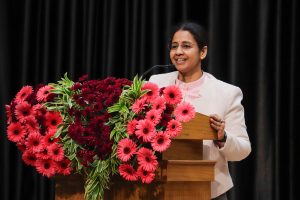
Every International Women’s Day is a new opportunity to render new definitions to womanhood. It calls the attention of the world to take a moment and marvel at the unimaginable, women across the globe have made possible. It is indeed incredible what the womenfolk has been contributing to the world amidst a thousand adverse circumstances. SRM University-AP proudly celebrated this women’s day by marking respect to women across different walks of life for the enormous grit and endurance they have put on. Smt KGV Saritha, Superintendent of Police, Women Protection Cell, CID-AP was the distinguished guest of the day. Her valuable presence and enriching experience added much essence to the day and made the celebrations more meaningful.
Ms Revathi Balakrishnan, Assistant Director, Student Affairs, welcomed the gathering. She introduced the history of the observance of women’s day which goes back to the early 1900s when women in the industrialised world raised their voices and rebelled against the harsh working conditions. She also enunciated the importance of celebrating the success story of every woman on a global scale.
Prof. V.S Rao, Vice-Chancellor delivered the presidential address. He started off by offering warm women’s day greetings to all the faculty, staff, and students. He also emphasized the importance of achieving the goals of the university by giving impetus to women’s empowerment. Citing various examples of renowned women leaders from different spheres, he reminded the unbeatable power of womanhood. He also recalled how the state government has formulated reservation policies that helped women of Andhra Pradesh to excel in the field of education. “The university also strives to open new vistas of learning for the girl students through different clubs such as the e-cell that promotes women entrepreneurship.” he asserted. While gender disparity continues to perpetuate even in the industrial capitals of the world, he reminded, how important it is for India to look up to countries like Bangladesh that have been taking extraordinary strides in empowering women over the last two decades.
Smt KGV Saritha, the chief guest of the day, addressed the gathering. She paid respect and obeisance to all the teachers of SRM University-AP and expressed her happiness to be a part of the university in the women’s day celebrations. Talking about ‘Gender Equality’ which is one of the Sustainable Development Goals of 2030, she articulated the relevance of this year’s IWD theme #BreakingTheBias. While taking references from myths and history to exemplify the fortitude of women, she did not overlook the record of men in India who have played a crucial role in placing women on high pedestals. She also took pride in the cultural and political legacy of the country that always honoured womanhood. “While ladies of many countries in the world are taking out to streets to choose their leaders, We Indians are proud to have a constitution which ensures the right of Indian women to choose their leaders through universal adult franchise,” she remarked.
Despite the prevalence of social evils like Child marriage and Sati, women in India like Savitribai Phule have stewarded various socio-religious movements to transform the patriarchal face of the Indian milieu. She went on to cite examples of Sindhuthai Sapkal, the great Indian social worker and Manasi Joshi, the Indian para-badminton player who have displayed the mettle of Indian womanhood by transforming their weaknesses into the greatest of their strengths. She called out to all the women to awaken their innate strength and break the biases they carry within. Revealing the mantra “Love Yourself, Respect Yourself, and Look at yourself with your own eyes”, she alerted all the women to pay attention to their physical fitness, mental agility, and emotional balance.
Further, Ms Revathi Balakrishnan introduced the Uttam Pratibha Mahila Awards, a new initiative of Prof. VS Rao foundation to honour the women who have been contributing to the welfare of the university. Awards were distributed across various categories such as security, landscaping, mess and canteen etc. All the women faculty, heads of various departments and other staff were also felicitated. Cultural events including dance performances, music medley presentations were also organised as part of the celebrations. Dr Arundhati Ghanwar, Associate Director-ITKM proposed the vote of thanks. She expressed gratitude to Smt KGV Saritha on behalf of the university for her inspiring presence on the day. She also thanked the vice-chancellor, other dignitaries and the management who continue to make this university a wonderful working place for all the women.
- Published in News
Introducing decentralized security system using blockchain technology
The Department of Computer Science and Engineering is delighted to announce that Dr Rajiv Senapati and his research group; Abhiram Chakravadhanula, Jaswanth Kolisetty, Karthik Samudrala and Bharat Preetham have published a research article titled “A Novel Decentralized Security Architecture for the Centralized Storage System in Hadoop using Blockchain Technology” in the Scopus indexed IEEE 7th I2CT (The premier conference for the latest discoveries in Convergence in Technology in Asia Pacific).
Over the past decades, the Big Data ecosystem is experiencing a humungous explosion in the generation and exchange of information. Trading such delicate information can serve as a profitable knowledge resource in the present economy. However, serious concerns have been raised about the security and assurance of delicate data as the conventional safety architecture in centralized storage systems does not meet its nuanced requirements. Blockchain technology offers a promising solution for big data protection due to its decentralized nature. Through this research article, Dr Rajiv Senapati and his students intend to introduce a decentralized security architecture in centralized storage systems such as Hadoop to address its existing vulnerabilities.
Abstract of the Research
Big Data is huge in volume, diverse in information, and growing at flourishing rates. The major distributed file systems in the current market in Big Data Analysis include Apache Hadoop, Storm, Cassandra, Flink, Cloudera, and many more. Hadoop is an open-source framework divided into Hadoop Distributed File System (HDFS) and Map-Reduce. Hadoop plays a leading role in storing and processing Big Data in contemporary society as it is cost-effective and can manage large volumes of data in low-cost commodity hardware. HDFS is a type of Data Warehouse which is scalable and has fast access to information.
Metadata is the information about the data, such as which block is storing on what datanode, how many replications that block has, and on which datanodes those replications reside. In HDFS, this metadata is stored at a fixed place in namenode, and attackers can access the metadata and modify it without notice. Also, metadata is mutable, which means the attacker can erase his presence easily.
In this paper, to resolve this issue, we have provided a mechanism using blockchain technology that follows a decentralized architecture against the centralized architecture followed by HDFS. Hyperledger Fabric (HLF) is the blockchain proposed to be effective and trusted for such a purpose. HLF is a private blockchain with a distributed immutable ledger. The metadata will be stored in the ledger. If an attacker tries to modify the data, he cannot erase his presence as the ledger is immutable, unlike HDFS. Further, the work proposed in this paper can be extended in real-time HDFS with a secure ledger and multiple nodes.
- Published in CSE NEWS, Departmental News, News, Research News


